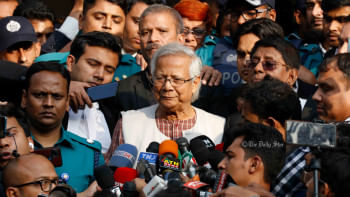Second-time infection drives up dengue deaths

One of the main reasons behind dengue deaths this year was second-time infection, while other reasons include late hospitalisation and comorbidity, according to the recent findings of the health directorate's death review committee.
"In our review, we've tried to find the reasons for this year's severity [of the infection]. We found that most of the patients were infected [with dengue] for the second time, which increased the mortality rate," said Prof Ahmedul Kabir, head of the committee and additional director general (administration) of the Directorate General of Health Services.
He said the risk for patients infected with dengue for the first time is far less than those infected for the second time. "And those who are infected for the third time, their condition turns fatal."
The death review committee assessed the background information of patients who have died from dengue so far this year, their medical documents, treatment records and causes of death.
The sample size was over half of the total deaths, Kabir said.
According to DGHS data, at least 1,699 dengue patients died, and 3,20,835 others were hospitalised till yesterday (December 27).
Experts said the changing patterns of the dengue virus, false results in testing kits, and the presence of serotypes DEN-2 and DEN-3 are some other reasons for the staggering number of deaths this year.
HM Nazmul Ahsan, associate professor of Shaheed Suhrawardy Medical College Hospital, said, "This year we got many patients coming to hospital in critical conditions within just a few days of getting infected. They had conditions like fluid in the abdomen and chest and a drop in blood pressure in a span of two or three days. We also found many patients without rashes [a common dengue symptom]."
In many cases, he said, test kits give false results. "As a result, patients end up coming to hospital only when their condition is already critical."
Nazmul said this year the presence of serotypes DEN-2 and DEN-3 was higher compared to previous years. "Among the four dengue serotypes, 2 and 3 are most dangerous."
The four viruses are called serotypes because each has different interactions with the antibodies in human blood serum.
HOW TO PREVENT DEATHS
Public health expert Mushtaq Hossain said changes in the current treatment management and strategy are necessary in order to bring down the dengue mortality rate in the country.
"If the government classifies dengue treatment and divides it into three parts -- primary, secondary and tertiary -- it would be easier to manage all the patients and the number of deaths would be reduced."
He added that developing and upgrading the primary healthcare system is also required so that patients would not need to crowd hospitals.
"Meanwhile, the government should develop secondary health facilities as well for critical patients to be treated there … City corporation hospitals and railway hospitals can be used as such facilities."
Mushtaq further suggested the setting up of more blood collection centres in Dhaka for dengue patients.
Outside the capital, he said, the government needs to develop the upazila health complexes and community clinics for tests and treatment with more equipment and manpower.
Nazmul Ahsan said the government needs to focus on improving dengue treatment and management at both rural and city levels, and facilitate the relevant authorities in this regard.
"Detecting dengue hotspots and breeding grounds early on is also important."
DGHS's Ahmedul Kabir said a National Strategic Plan has been prepared, highlighting the involvement of entomologists, responsibilities of relevant ministries, and the need for a multisectoral approach and community engagement, to tackle the dengue menace.
"We'll send it to the health ministry soon. If it accepts the plan, then we can take initiative early and put it into effect before next year's outbreak."

 For all latest news, follow The Daily Star's Google News channel.
For all latest news, follow The Daily Star's Google News channel. 




Comments